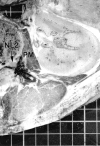A new simplified sonographic approach for pararadicular injections in the lumbar spine: a CT-controlled cadaver study
- PMID: 21349957
- PMCID: PMC7965556
- DOI: 10.3174/ajnr.A2389
A new simplified sonographic approach for pararadicular injections in the lumbar spine: a CT-controlled cadaver study
Abstract
Background and purpose: Injection therapies play a major role in the treatment of lower back pain and are to date performed mainly under CT or fluoroscopic guidance. The benefits of US-guided instillation procedures have been shown in many studies. We conducted this study to simplify an US-guided approach to the lumbar spinal nerves and to assess the feasibility and preliminary accuracy by means of CT and anatomic dissection.
Materials and methods: Ten US-guided injections at 5 different levels (L1-L5) were performed on 1 embalmed cadaver. Images in 3 sagittal/parasagittal scanning planes were obtained at each lumbar level: 1) the plane of the spinous processes, 2) the plane of the lumbar arches/zygapophyseal-joints, and 3) the plane of the transverse processes. The PAP was then defined by positioning the transducer perpendicularly over the medial part of the respective transverse processes, depicting the hyperechoic intertransverse ligament. In the "in-plane technique," spinal needles were advanced through the respective segmental intertransverse ligament. A solution consisting of a contrast agent and a pigmented dispersion was subsequently injected into the pararadicular compartment. An anatomic dissection of the specimen and CT scans were performed to verify the exact placement of the needle tips and to evaluate fluid dispersion in the punctured compartment.
Results: CT examination confirmed that each needle tip was correctly placed within the intended compartment with sufficient contrast accumulation around the respective proximal segment of the spinal nerve. On each anatomic section, dye was identified in the correct compartment and directly around each targeted spinal nerve with needles shown in the correct position.
Conclusions: This modified US approach for therapeutic root injections in the lumbar spine by using the intertransverse ligament as a new anatomic landmark allows an easy and correct needle placement within the pararadicular compartment.
Figures








Similar articles
-
Ultrasound guided versus CT-controlled pararadicular injections in the lumbar spine: a prospective randomized clinical trial.AJNR Am J Neuroradiol. 2013 Feb;34(2):466-70. doi: 10.3174/ajnr.A3206. Epub 2012 Jul 19. AJNR Am J Neuroradiol. 2013. PMID: 22821925 Free PMC article. Clinical Trial.
-
A simple approach for ultrasound-guided pararadicular injections in the sacral spine: a pilot computer tomography controlled cadaver study.Med Ultrason. 2019 May 2;21(2):125-130. doi: 10.11152/mu-1823. Med Ultrason. 2019. PMID: 31063514
-
Ultrasound-guided Pararadicular Injection in the Lumbar Spine: A Comparative Study of the Paramedian Sagittal and Paramedian Sagittal Oblique Approaches.Pain Pract. 2015 Nov;15(8):693-700. doi: 10.1111/papr.12249. Epub 2014 Oct 14. Pain Pract. 2015. PMID: 25313534 Clinical Trial.
-
[Imaging-guided injection techniques of the lumbar spine].Orthopade. 2013 Apr;42(4):281-94. doi: 10.1007/s00132-013-2078-0. Orthopade. 2013. PMID: 23575561 Review. German.
-
Sonographically guided lumbar spine procedures.J Ultrasound Med. 2013 Jul;32(7):1109-16. doi: 10.7863/ultra.32.7.1109. J Ultrasound Med. 2013. PMID: 23804333 Review. No abstract available.
Cited by
-
Transverse process and needles of medial branch block to facet joint as landmarks for ultrasound-guided selective nerve root block.Clin Orthop Surg. 2013 Mar;5(1):44-8. doi: 10.4055/cios.2013.5.1.44. Epub 2013 Feb 20. Clin Orthop Surg. 2013. PMID: 23467334 Free PMC article.
-
Chinese Association for the Study of Pain: Experts consensus on ultrasound-guided injections for the treatment of spinal pain in China (2020 edition).World J Clin Cases. 2021 Mar 26;9(9):2047-2057. doi: 10.12998/wjcc.v9.i9.2047. World J Clin Cases. 2021. PMID: 33850924 Free PMC article. Review.
-
Ultrasound guided versus CT-controlled pararadicular injections in the lumbar spine: a prospective randomized clinical trial.AJNR Am J Neuroradiol. 2013 Feb;34(2):466-70. doi: 10.3174/ajnr.A3206. Epub 2012 Jul 19. AJNR Am J Neuroradiol. 2013. PMID: 22821925 Free PMC article. Clinical Trial.
-
Ultrasound imaging and guidance in the management of post-injection sciatic neuropathy: Love, loss and space.Turk J Phys Med Rehabil. 2020 May 18;66(2):225-226. doi: 10.5606/tftrd.2020.5897. eCollection 2020 Jun. Turk J Phys Med Rehabil. 2020. PMID: 32760903 Free PMC article. No abstract available.
-
Ultrasonographic Imaging Protocol and Sonoanatomy of the Lumbar Spine in Healthy Dogs.Animals (Basel). 2022 May 6;12(9):1187. doi: 10.3390/ani12091187. Animals (Basel). 2022. PMID: 35565613 Free PMC article.
References
-
- Bogduk N. On the definitions and physiology of back pain, referred pain, and radicular pain. Pain 2009; 147: 17–19 - PubMed
-
- Moore RA, Straube S, Derry S, et al. . Chronic low back pain analgesic studies: a methodological minefield. Pain 2010; 149: 431–34 - PubMed
-
- O'Neill S, Graven-Nielsen T, Manniche C, et al. . Ultrasound guided, painful electrical stimulation of lumbar facet joint structures: an experimental model of acute low back pain. Pain 2009; 144: 76–83 - PubMed
-
- Schiltenwolf M, Schneider S. Activity and low back pain: a dubious correlation. Pain 200;143:1–2 - PubMed
-
- Carrino JA, Morrison WB, Parker L, et al. . Spinal injection procedures: volume, provider distribution, and reimbursement in the US Medicare population from 1993 to 1999. Radiology 2002; 225: 723–29 - PubMed
MeSH terms
LinkOut - more resources
Full Text Sources
Research Materials
